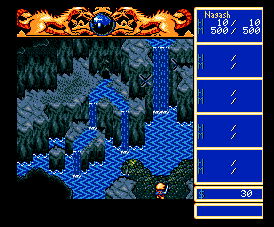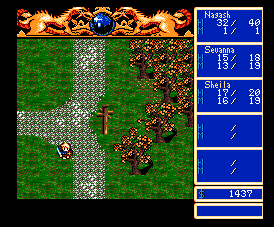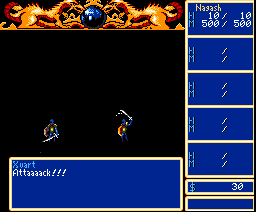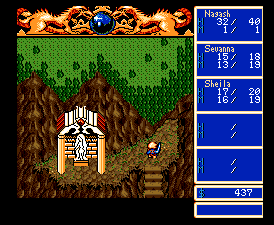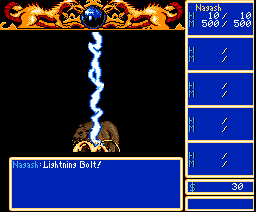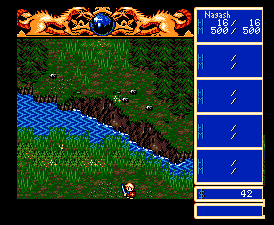|
At the International Computer fair in Tilburg of this year, Umax presented their new RPG: Realms of Adventure. It took a while since The Lost World, but they did it again. And this time it’s even better than before! |
|||
|
|||
|
Directory
What you get The game Umax RPG style Battling evil Non-linear Graphics Music Conclusion |
|||
|
|
|||
|
|
|||
|
|||
|
|
At the Tilburg fair of 1999, there was already a preview of this game and it looked very cool. Now, a year later, the game is finally finished and everybody can start a new Umax adventure on his MSX. If you enjoyed games like Dragon Slayer 6, Pumpkin Adventure III and The Lost World this new Umax game will not disappoint you.
What you get
The game is delivered in a full colour video-sized box, with some snapshots and this
message on the back: ‘Prepare to be immersed into a complex world of magic and adventure.
Take on the role of Nagash Silverstone and head out into the world, looking for adventure’. That sounds good!
The box contains one disk — the Master Disk —, with a
nice full colour label on it, two seperate black/white A4 sheets of paper with
a map of the land the adventure starts in and a map of the world. Last and
certainly not least there is a nice manual with a coloured cover and lots of information on the game.
My version was in Dutch, it seems logical to me that there is also a version in
English available.
A funny detail: the box has just room for two disks and the manual. There will be more parts — see below — but where do we have to put all these disks then?
|
The manual is very detailed, it is divided in several parts telling all about the game and its many options. The first part tells the story, which is more detailed than the intro story in the game itself.
After this you can find lots of explanation about the options of the game, about all the menus and a list of weapons and potions which you can find in the game. All this info seems very useful because of the many options and the complexity of the game. In the end there is a small walktrough so you can get started easily.
The game
Realms of Adventure (RoA) can be played from the disk or it can be installed on
harddisk. This can be done easily, and you don’t have to have the first disk
in the drive at startup for checking the copy protection, as was necessary in PA3.
I played RoA from harddisk and after a few seconds of loading and the well-known ‘Stichting Sunrise’ logo, the title screen appears.
After a push on the fire button or spacebar a new screen appears which shows a dragon and the intro story scrolling upwards.
After reading the story of Nagash Silverstone going on adventure or a push on
the spacebar you can choose between ‘New Game’ or ‘Load Game’.
Of course I start with a new game, and after a few words and a view on the village Abernus where the adventure starts, the game can really begin!
|
Umax RPG style
If you know the previous Umax RPGs I don’t have to explain much about what the
game looks like, but for those who do not I will explain it anyway.
The game screen is separated in two parts. Most of the screen is occupied by the playing field. On the right side of the screen there is information about your party — the people who you are with and their status — and the amount of money you have. The playing field does not scroll like in e.g. Xak, but it has ‘rooms’ — like in Metal Gear — which are changed if you walk through the ‘edges’ of the screen.
|
As in every other RPG, the player can walk through many lands, villages, caves and forests. When walking around you will face monsters and demons which you can fight to gain money and experience. In RoA you will face monsters randomly: most of them you can’t see in the playing field; you just suddenly go into the battle screen where you can fight. In caves, dungeons and castles you can see the monsters. I’ll tell you more about fighting later. With a push on the button you will get into the menu. Here are many options accessible. Most, like Spells, Object Scroll and Status are about the same as in other RPGs. However, there are many extra options in this particular game! Think about mixing herbs e.g., at the sorcerer’s. Compared to other games like Pumpkin Adventure III, the status of a character is more detailed. In this game there is also information about the character’s sex, alignment (good or bad) class and mental status. The latter features very nice details; you can be drunk or in love, for example.
One other difference in RoA compared to the other Umax RPGs is that you don’t have to walk for hours to get somewhere. Near the most important locations in the game are roadsigns. Just bump into them and you can choose to what other roadsign you want to travel. Very comfortable, just as the fact that you don’t have to slay a zillion monsters to get money: in this game you can sell your weapons and other items. New is also that there is a difference between group and party. The party consists of the people walking with you — like in PA3 and The Lost World, or even Dragon Slayer 6 — and the group is the total amount of people working with you. You can only take four extra characters with you on your journeys, but the group can be much larger. Group members not going with you will stay behind in the Inn. You have to decide for yourself if you want to add characters to your group when they ask you to. And of course you also have to assemble the party yourself, making it the most suitable one for your current quest.
|
Battling evil
Of course this is an important part of the game, because with fighting you can
collect money and experience to get a higher level and become stronger. As said,
you enter the battle screen when you run into a monster. On the bottom of this
screen are some options like strike (attack), status, scroll, item, spell — use
one in the battle — and parry. The latter is also something new: with this one
you can exclude a character from the battle, so it can’t strike and can’t get
hit, which can be very handy sometimes.
The top part of the screen, the biggest part, is where the monsters you are
facing are shown. Below the monster is its number of hit points and with a small
arrow you can select the monster you want to hit.
Non-linear
The major difference between RoA and almost all of the other MSX RPGs is that this game is
non-linear. The player can make decisions in the game during
conversations, when finding objects or facing a monster, which means you are in
control of how the story will continue. Every time you play the game the story
will be different because you make other decisions. This means the game is very nice
to play again, after finishing it, because then you will have more experience in
playing the game so you will make better decisions.
Of course there is a main storyline in the game, but you can advance in the game in many different ways.
|
The game consists of many different main quests, only after finishing such a quest you go to the next part of the game. But within these quests there are many different subquests; these can vary from saving a man’s daughter or finding an object to saving a village from evil creatures. These subquests don’t have to be done, but you can often gain money, reputation (!), objects, weapons, information or something else useful by finishing them. Sometimes someone asks you to do such a quest and sometimes you can do one because you did something special. On the first game disk there is one main quest — part one — and I have discovered about seven subquests.
Not in the least because of the quests system, it is possible to make a very large game: as far as I heard there will be at least 15 more parts. It’s also possible to let Umax know your ideas for quests which they can fit into the game. If you have some, mail Peter Meulendijks: PeterMilldyke@hetnet.nl.
|
Graphics
The graphics are just as in the previous Umax RPGs mostly from Peter
Meulendijks’s hand and are absolutely great.
The lands and villages you can walk through look beautiful and the houses, bars
and other buildings are very detailed.
A difference with e.g. The Lost World are
the monsters. In RoA part 1, these are not very big and don’t look so
nice.
However, the monsters you see in the battle screen
are animated! Wolves walk from left to right, knights swing their swords
and blood splatters when you hit a monster. This is very unique
and it is a very cool detail.
Music
When the first music starts you think: ‘Hey, I already know this one!’. Most
of the themes are from previous Umax RPGs — PA3, The Lost World — because they
couldn’t find a composer who wanted to make new musics.
Officially only the FM-Pac is supported, but since the original compositions
are for both FM-Pac and Music Module, the Music Module is used as well.
However, since there is no samplekit loaded, you hear a lot of buzzing from
the Music Module’s sample channel, so it would be best to disconnect the Music Module before
playing. A silly thing which could easily have been avoided. There is no Moonsound
music yet, but Peter announced that there might be updates for Moonsound music
on the Bussum MSX fair in September.
Most of the musics are nice to listen to, but if you have played other Umax RPGs you will recognize most of them and then it can be pretty boring.
|
Conclusion
A typical Umax game: a great story, nice graphics. Very original is the great
amount of details in the status of characters which makes them more real. The
quests makes the game nice and fun to play and very varying.
Too bad the monsters are not very big and detailed, I always liked that, but the animations are very cool and original. By the way, Peter wrote that future parts will contain larger monsters. A shame that no one wanted to make new musics for this game, especially for all who have played other Umax RPGs. When writing this the second disk is still not ready. I hope that it will not take too much time between each new part, because it’s very irritating when you have finished a part and you can’t continue because you don’t have the disk.
RoA has lots of good things from RPGs like Pumpkin Adventure, Dragon Slayer 6 and Xak combined and that makes it a perfect game for everyone who likes RPGs like I mentioned before. Absolutely a game you should buy if you are a lover of RPGs.
A last remark: Peter wrote on the MSX mailinglist that the first disk was actually only the master disk and they added some gameplay to get people interested. He said the actual game will start at part 2, continuing where part 1 ended. In part 2 they want to cover the whole first world, which will be about 5 or 6 disks in size. There will also be a new master disk then, because they made some improvements that cannot be patched.

